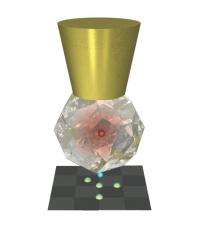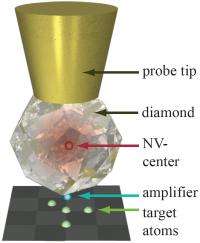Amplifier helps diamond spy on atoms

(PhysOrg.com) -- An ‘amplifier’ molecule placed on the tip of a diamond could help scientists locate and identify individual atoms, Oxford University and Singapore scientists believe.
The idea builds on ongoing work towards creating a diamond nanocrystal that can be used to detect an atom’s incredibly weak magnetic field. Defects within the diamond hold electrons that act rather like a compass, lining up with even the very weak magnetic field emanating from the core of an atom.
Crucially this diamond compass can be ‘read’ by shining a pulse of laser light into the crystal giving information about the location and type of atom – for instance telling the difference between a carbon and hydrogen atom and giving their exact location within a structure such as a virus or new material.
‘The problem with this approach is that the ‘compass’ only behaves well if it is buried within the diamond: this makes it very difficult to get it close enough to a structure to detect an individual atom’s magnetic field,’ said Dr Simon Benjamin of Oxford University’s Department of Materials and National University of Singapore. ‘It’s a bit like trying to grasp one particular marble out of a bucket of marbles whilst wearing an oven glove.’
The new research, which the team report this week in Physical Review Letters, calculates that by attaching another ‘compass’ – the amplifier molecule – to the tip of the diamond this will pass the information about an atom along to the compass inside the diamond that can then be read.
‘Our calculations show for the first time how such an amplifier could be used to make a diamond probe sensitive enough to pinpoint and identify individual atomic cores,’ said Dr Benjamin. ‘If this can be made to work, the additional information we would gain would be rather like moving from black and white photographs of atoms to full colour.’

Dr Erik Gauger of Oxford University’s Department of Materials and National University of Singapore, an author of the paper with Dr Benjamin, said: 'The device that we propose may well represent the limit of what is possible in terms of magnetic field sensitivity and resolution; if, as we hope, it allows direct identification of atoms by their core signatures, then it will be a revolutionary tool in chemistry, biology and medicine.’
The team believe that it may only be a couple of years before diamond probes are created that will reveal the world of the atom in unprecedented detail but that the small step of adding an amplifier could make such systems many times more powerful.
More information: A report of the research, entitled ‘Spin Amplification for Magnetic Sensors Employing Crystal Defects’, is published in this week’s Physical Review Letters. Go to: link.aps.org/doi/10.1103/PhysRevLett.107.207210
Journal information: Physical Review Letters
Provided by Oxford University




















